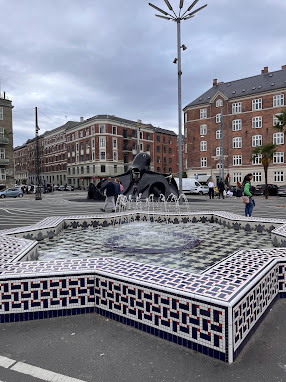Denmark vs. The Netherlands
A child navigating this crazy intersection on bike. Cycling in The Netherlands is such a surreal experience. It seems like chaos at first, but in reality, everyone is aware and looking out for each other and themselves. In Copenhagen, it was easier to ‘cycle mindlessly’ and pay less attention to my surroundings since I relied on lights and bells to tell me when and when not to move. Amsterdam is not like that, often the lights are not listened to, and people go through the intersection when the lights are red because there is no one coming, or there are no lights at all. The picture above shows an intersection where no lights or street signs are present. There are some yielding arrows on the ground, but mainly the intersection is based on awareness, flow, and social trust. I sat at this intersection for several minutes, watching how people navigated it. There is no hierarchy or necessity to stop for a specific transportation mode, it just relies on the safest and most convenient way of moving around, crossing paths, and looking out for one another. I prefer different aspects of each city (Copenhagen vs. Amsterdam) when it comes to biking infrastructure. When looking at it from a newcomer’s point of view, cycling in a new city, especially if you are a new cyclist, Denmark is definitely the place to do it. The rules in Denmark allow for a strong sense of safety, knowing everyone is on the same page. However, that can also cause the feeling of having a lack of safety, considering there’s less room for error. In the Netherlands, when a mistake is made, like a turn that cuts someone off, people adapt and change course, and seem overall more aware of their surroundings and movements. In Copenhagen, when a mistake like that is made, it is breaking the rules that everyone follows, and can often have a greater impact of crashing or causing problems in the flow. While, even as a relatively new cyclist, I prefer the Netherlands, I believe Copenhagen's creation of bicycle infrastructure is more applicable when it comes to transferring these ideas to US cities. Adequate bicycle infrastructure is really lacking in the US, and in order to provide safe and welcoming support for new and curious cyclists, a separated, understandable, and rule-oriented system is required. |
 Underwater bike garage entrance. |
 |
| Getting my bike onto an upper-level parking spot. |
 |
Three-tier bike rack so several bikes can fit on one. |







So fun to see all of this through your eyes.
ReplyDelete